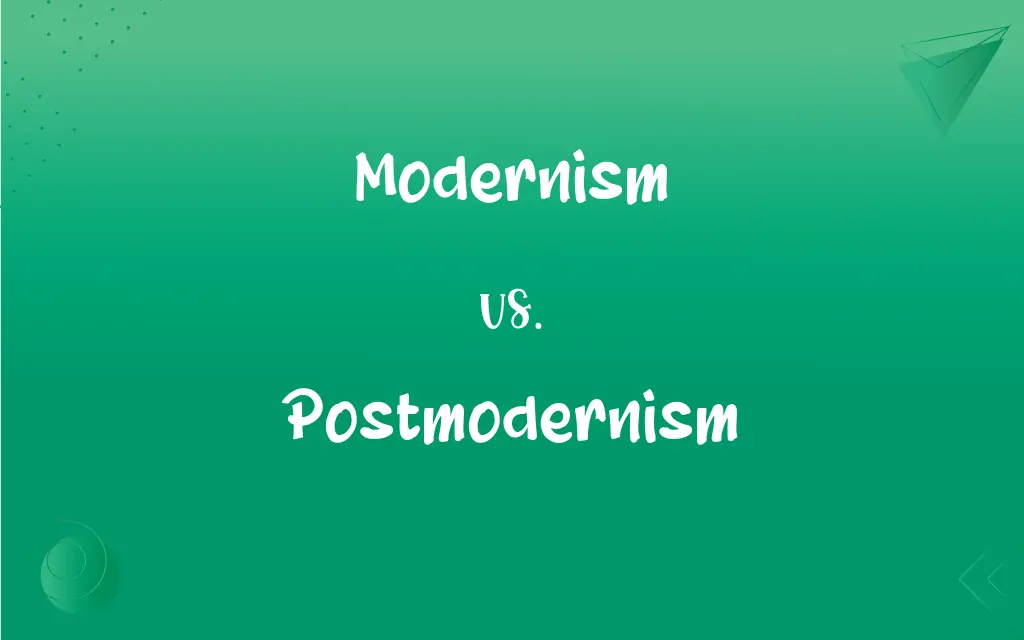Modernism vs. Postmodernism: What's the Difference?
Edited by Aimie Carlson || By Harlon Moss || Updated on October 12, 2023
Modernism emphasizes objectivity and progress through structure and order, while postmodernism values subjectivity, denies absolute truths, and challenges established norms, embracing paradox and fragmentation.

Key Differences
Modernism and postmodernism, two influential movements, notably diverge in their approaches towards truth and narrative structure. Modernism, deeply rooted in the Enlightenment’s ideals, upholds an overarching, often optimistic belief in reason and progress. On the contrary, postmodernism dismisses the concept of universal truths or narratives, thereby dismantling modernist structures, and seeking multiplicity in meanings and interpretations.
Aesthetic distinctions between modernism and postmodernism highlight their ideological chasm. Modernism, nurturing a penchant for abstraction and formality, often strives to represent a deeper, universal truth or reality. In stark contrast, postmodernism revels in surface play, paradox, and irreverence, deliberately confounding expectations and melding high and low cultural forms to challenge prevailing hierarchies and divisions.
Ethical and philosophical underpinnings differentially mold modernism and postmodernism. Modernism tends to lean towards moral absolutes and definitive ethical frameworks, ostensibly reflecting a collective moral and social progress. Conversely, postmodernism, navigating away from moral certainties, encourages a plurality of perspectives and ethical relativism, thus refracting moral and ethical discussions through a multitude of lenses.
From a socio-political viewpoint, modernism often encompasses a belief in progress and the potential of social structures to foster improvement. In contrast, postmodernism, inherently skeptical of meta-narratives, disrupts these notions, interrogating and parodying them to highlight their limitations and exclusionary natures, thereby providing space for alternative, marginalized narratives to emerge and be recognized.
Regarding methodology and approach, modernism frequently seeks clarity, coherence, and a somewhat deterministic view of cause and effect within societal and artistic contexts. In a countermove, postmodernism, shrouded in ambiguity and contradiction, defies clear categorization or linear methodologies, opting instead for a more fragmented, decentralized, and multi-faceted approach, which expands the horizons of interpretive possibilities.
ADVERTISEMENT
Comparison Chart
View on Truth
Believes in universal truths
Rejects absolute truths
Aesthetic Approach
Seeks abstraction and formality
Embraces surface play and paradox
Ethical Underpinnings
Leans towards moral absolutes
Encourages ethical relativism
Socio-political Beliefs
Faith in progress and social structures
Skeptical and critical of meta-narratives
Methodological Approach
Values clarity and coherence
Adopts ambiguity and contradiction
ADVERTISEMENT
Modernism and Postmodernism Definitions
Modernism
Modernism seeks to articulate universal truths and principles.
Picasso's innovative artworks embraced modernism by exploring new methods to convey universal themes.
Postmodernism
Postmodernism rejects overarching narratives, opting instead for local and personal stories.
The text Infinite Jest embraces postmodernism by weaving numerous interconnected stories, rejecting a single overarching narrative.
Modernism
Modernism often expresses a belief in progress and the potential of humanity to ascend through knowledge.
Through towering skyscrapers and organized urban plans, architectural modernism envisioned a progressive future.
Postmodernism
Postmodernism merges high and low cultural forms to critique established hierarchies.
Andy Warhol's art reflects postmodernism by equating consumer products with high art, blurring established boundaries.
Modernism
Modernism emphasizes clarity, order, and structured approaches in art and literature.
Through its structured poetic form, Eliot's The Waste Land embodies aspects of modernism.
Postmodernism
Postmodernism fosters a skeptical view of progress and grand theories, encouraging scrutiny and dissent.
Blade Runner represents postmodernism by critically examining notions of progress and humanity through a dystopian lens.
Modernism
Modernism involves the exploration and formulation of new narrative techniques and forms.
Stream of consciousness in Joyce's Ulysses illustrates modernism’s experimental narrative techniques.
Postmodernism
Postmodernism employs pastiche, parody, and irony to destabilize other texts and ideologies.
The Simpsons employs postmodernism by utilizing parody and irony to critique various aspects of culture and society.
Modernism
Modernism carries an implicit trust in established social and political structures to foster societal betterment.
Modernism manifested in literature often showcased characters who sought meaning through societal structures.
Postmodernism
Postmodernism challenges the existence of absolute truths and embraces relative perspectives.
The novel White Noise by Don DeLillo exemplifies postmodernism through its exploration of relative truths within media-saturated culture.
Modernism
Modern thought, character, or practice.
Postmodernism
Of or relating to art, architecture, or literature that reacts against earlier modernist principles, as by reintroducing traditional or classical elements of style or by carrying modernist styles or practices to extremes
"It [a roadhouse]is so architecturally interesting ... with its postmodern wooden booths and sculptural clock" (Ruth Reichl).
Modernism
Sympathy with or conformity to modern ideas, practices, or standards.
Postmodernism
Of or relating to an intellectual stance often marked by eclecticism and irony and tending to reject the universal validity of such principles as hierarchy, binary opposition, categorization, and stable identity.
Postmodernism
Any style in art, architecture, literature, philosophy, etc., that reacts against an earlier modernist movement.
Postmodernism
An attitude of skepticism or irony toward modernist ideologies, often questioning the assumptions of Enlightenment rationality and rejecting the idea of objective truth.
Postmodernism
Genre of art and literature and especially architecture in reaction against principles and practices of established modernism
FAQs
When did modernism reach its peak?
Modernism was particularly influential in the early to mid-20th century.
What is the primary focus of modernism?
Modernism seeks universal truths and embraces clear structures and order.
Does postmodernism follow a clear structure like modernism?
No, postmodernism often rejects clear structures, embracing ambiguity and fragmentation.
How does postmodernism perceive societal progress?
Postmodernism tends to be skeptical about the concept of societal progress.
How does postmodernism view truth?
Postmodernism generally rejects the idea of absolute or universal truths.
Does modernism respect existing hierarchies?
Modernism may challenge existing hierarchies but usually maintains some belief in structured order.
Does postmodernism criticize modernist principles?
Often, postmodernism critiques and challenges the principles and assumptions of modernism.
What role does rationality play in modernism?
Rationality is often esteemed in modernism as a means to understand and shape the world.
Are modernism and postmodernism limited to specific art forms?
No, both can be identified across various art forms, including literature, architecture, and visual arts.
What does pastiche mean in postmodern contexts?
Pastiche refers to the combination of various elements, often from different sources or styles, into a single work.
How does postmodernism view authority and expertise?
Postmodernism typically challenges and deconstructs the concepts of authority and expertise, valuing multiple perspectives.
Can modernism involve experimental elements?
Yes, modernism often experiments with form and structure in search of deeper truths.
Is modernism inherently optimistic?
While not always optimistic, modernism often holds a belief in the potential of progress and rationality.
Do postmodern works utilize parody?
Yes, postmodernism frequently employs parody and irony to critique existing ideas and forms.
How does modernism view traditional norms?
Modernism often breaks from tradition, offering new forms and perspectives, yet maintains faith in overarching narratives.
Can postmodernism include elements of modernism?
Yes, postmodernism often incorporates and simultaneously critiques or deconstructs elements of modernism.
How does postmodernism treat genre boundaries?
Postmodernism frequently blurs and crosses genre boundaries, challenging their validity.
Is science fiction associated with modernism?
While not exclusive to it, science fiction can explore modernist themes like progress and human potential.
Can modernist works be nonlinear?
Yes, modernist works can feature nonlinearity as they experiment with new narrative forms.
What is meta-narrative in the context of postmodernism?
Meta-narrative refers to a large-scale, overarching theory or story that attempts to explain large-scale structures.
About Author
Written by
Harlon MossHarlon is a seasoned quality moderator and accomplished content writer for Difference Wiki. An alumnus of the prestigious University of California, he earned his degree in Computer Science. Leveraging his academic background, Harlon brings a meticulous and informed perspective to his work, ensuring content accuracy and excellence.
Edited by
Aimie CarlsonAimie Carlson, holding a master's degree in English literature, is a fervent English language enthusiast. She lends her writing talents to Difference Wiki, a prominent website that specializes in comparisons, offering readers insightful analyses that both captivate and inform.
































































